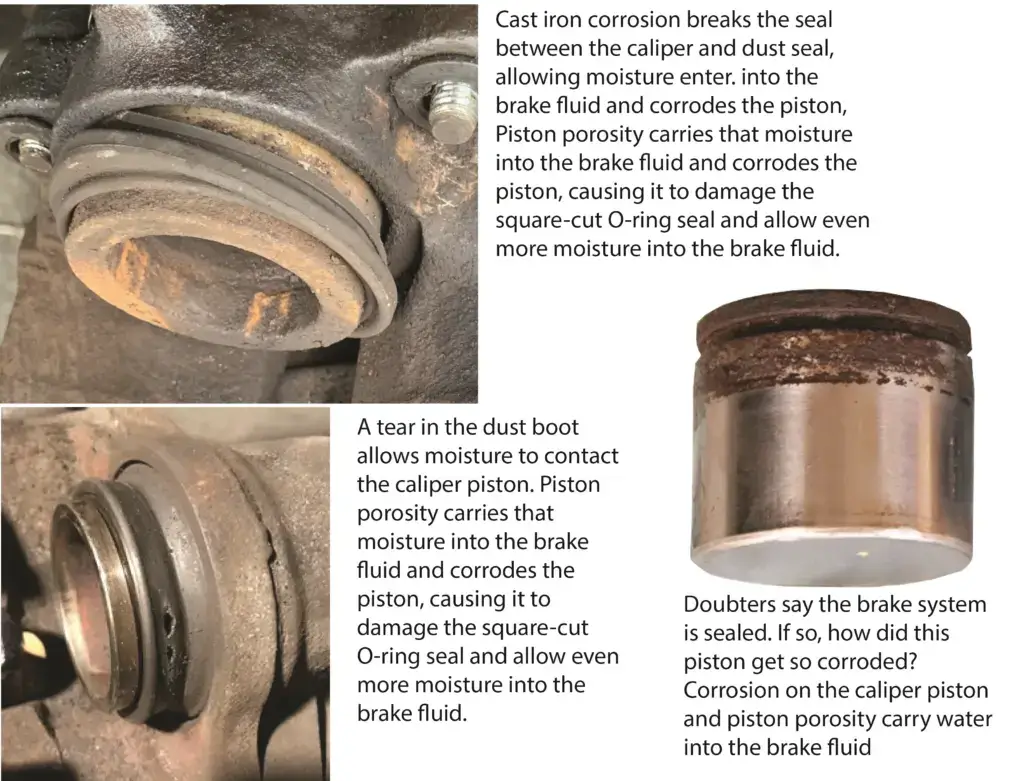Why vehicles need the brake fluid change periodically
A brake fluid change restores anti-corrosion additives and gets rid of moisture
Most carmakers recommend a brake fluid change every two or three years. The base chemical in brake fluid never goes bad, but the anti-corrosion additives wear out and that sets up internal corrosion. In addition, brake fluid absorbs moisture and that can reduce the fluid’s boiling point; the last thing you want in your brake fluid.
Why brake fluid absorbs moisture (water)
Brake fluid is hygroscopic, which means it tends to absorb moisture from the surrounding environment. The intrusion of moisture into your car’s brake system is a gradual but inevitable process that can significantly compromise the effectiveness of the brakes. But how exactly does moisture find its way into an automotive brake system?
How moisture gets past the seals in a brake system
In theory, an automotive brake system is a sealed system. In reality, there are several places where moisture can enter the system. Here’s where moisture enters a brake system.
Moisture gets into the brake fluid through the breather Holes In the Master Cylinder Reservoir Cap
The cap on the master cylinder reservoir has a rubber diaphragm inside that’s designed to seal the master cylinder and keep moisture out. However, as your brakes wear and the caliper pistons extend out farther, the fluid level in your reservoir drop, creating a vacuum under the cap. That causes the diaphragm to get sucked down into the reservoir. At a certain point, breather holes in the diaphragm allow air into the reservoir to relieve the vacuum on the diaphragm. That incoming air contains moisture and it’s instantly absorbed by the brake fluid
Rubber seals are slightly permeable, allowing moisture to combine with the brake fluid
Just like tires that loose air over time due to rubber permeation, the rubber hoses and seals in a brake system are also slightly permeable, allowing for minute amounts of moisture to seep in over time, especially as they age and wear.
Metal porosity in caliper and wheel cylinder pistons, along with corrosion around dust seals allow moisture to enter brake fluid
Caliper pistons and wheel cylinders carry moisture into the brake fluid
Both the caliper and wheel cylinder contain a “dust boot” designed to seal out dust and moisture. However, the rubber boot grips to the cast iron caliper or wheel cylinder. Over time, the cast iron ridge develops corrosion and the seal is no longer airtight, allowing moisture to contact the caliper piston and wheel cylinder piston. Porosity in the piston can carry moisture past the caliper’s square-cut O-ring seal or the wheel cylinder’s piston cup. That moisture is instantly absorbed by the brake fluid.

Corrosion on the wheel cylinder-to-sealing boot allows moisture to enter the wheel cylinder where the moisture is literally squeegeed into the brake fluid by the rubber piston cup.
 The brake system is a complex network of parts and connections. Over time, microscopic gaps can form at the joints and fittings, becoming potential entry points for moisture.
The brake system is a complex network of parts and connections. Over time, microscopic gaps can form at the joints and fittings, becoming potential entry points for moisture.
Condensation in the master cylinder reservoir causes water absorption by the brake fluid
Temperature changes can also lead to condensation within the brake system. When your vehicle is not in use, especially in colder climates, condensation can form and introduce moisture into the brake fluid.
©, 2023 Rick Muscoplat
Posted on by Rick Muscoplat